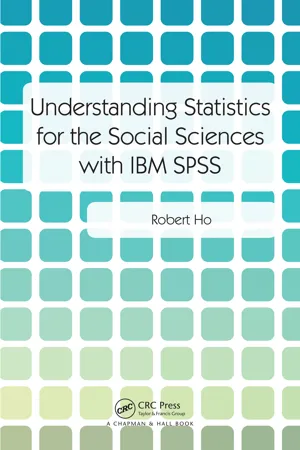
- 280 pages
- English
- ePUB (mobile friendly)
- Available on iOS & Android
Understanding Statistics for the Social Sciences with IBM SPSS
About This Book
Modern statistical software provides the ability to compute statistics in a timely, orderly fashion. This introductory statistics textbook presents clear explanations of basic statistical concepts and introduces students to the IBM SPSS program to demonstrate how to conduct statistical analyses via the popular point-and-click and the "syntax file" methods. The focal point is to show students how easy it is to analyse data using SPSS once they have learned the basics.
-
- Provides clear explanation of basic statistical concepts that provides the foundation for the beginner students' statistical journey.
-
- Introduces the SPSS software program.
-
- Gives clear explanation of the purpose of specific statistical procedures (e.g., frequency distributions, measures of central tendencies, measures of variability, etc.).
-
- Avoids the conventional cookbook approach that contributes very little to students' understanding of the rationale of how the correct results were obtained.
The advantage of learning the IBM SPSS software package at the introductory class level is that most social sciences students will employ this program in their later years of study. This is because SPSS is one of the most popular of the many statistical packages currently available. Learning how to use this program at the very start not only familiarizes students with the utility of this program but also provides them with the experience to employ the program to conduct more complex analyses in their later years.
Frequently asked questions
Information
Table of contents
- Cover
- Half Title
- Title Page
- Copyright Page
- Contents
- Preface
- Author
- 1. Introduction to the Scientific Methodology of Research
- 2. Introduction to SPSS
- Section I: Descriptive Statistics
- Section II: Inferential Statistics
- Appendix
- Bibliography
- Index